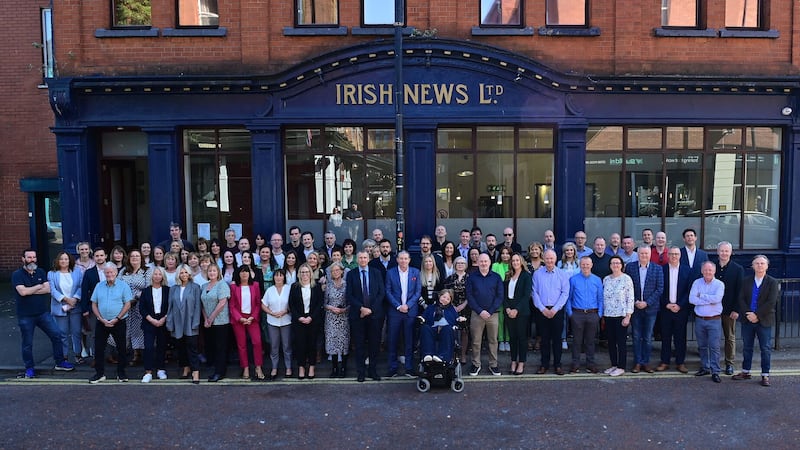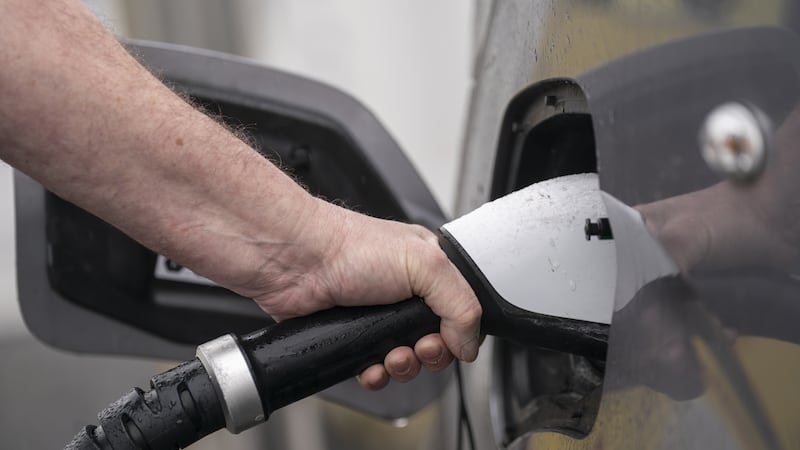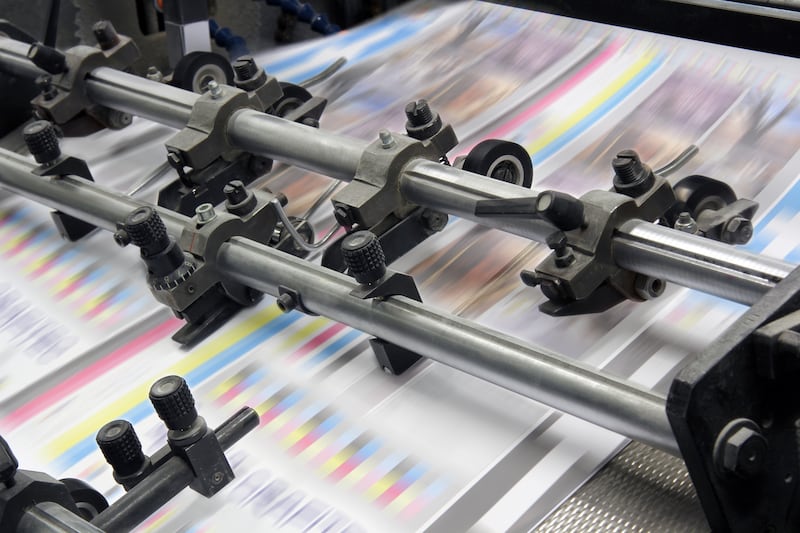DURING late summer 1959, Dr Dan McSparran, chairman then of the Irish News, offered me a job with the newspaper. He lived directly across the street in my home village of Knocknacarry.
Dr Dan was still also the chairman of Belfast Celtic FC, even though the famous club was out of the footballing scene since the late 1940s. He had been on that team trip to the USA when Celtic beat Scotland in a friendly.
Part of my mixed routine was to act as his chauffeur, driving a big green coloured saloon up to Celtic Park, where he checked on any mail for Celtic FC, which was still a live company until later sold to become a shopping centre.
Also at the famous ground - apparently to keep watch on the place, then in full swing as a greyhound track - was the old Celtic team masseur, Paddy McGuigan, who ran a private physio business from his house in the street opposite the Falls Road's Beehive Bar.
On occasions, I would be invited to drive Dr Dan down to Loughinisland to the Fitzpatrick family home where he would be deep in business discussion with his great friend and fellow Irish News company director, James Fitzpatrick, Snr.
More often the business talks would be privately held on a Monday morning in the Irish News secretary's office, a 'holy of holies' once adorned with a large compilation of photographs of Belfast Celtic officials, management and legendary players.
Dr Dan's daughter, Mary, was the company secretary and became my great supporter and mentor. I started out doing everything at the Irish News, a jack of all trades. Later Miss McSparran encouraged my progress in journalism. She gave me her typing instruction book and advised me to start a course in shorthand and typing at Orange's Academy.
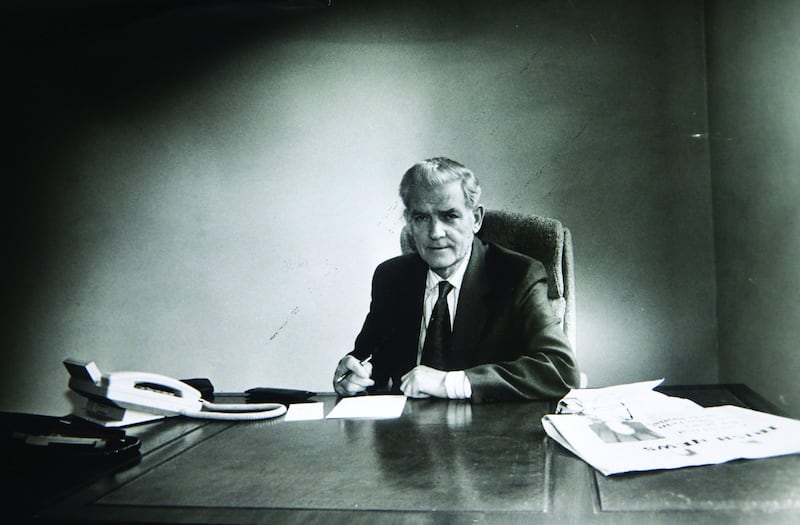
I was appointed Ireland's youngest newspaper circulation manager, taking over from Joe Feeney, father of present-day Irish News political columnist, Brian Feeney.
Joe retired from the Irish News to open a newsagent's on the lower end of the Springfield Road, close to Jack 'Sausage' Vernon's butcher's shop.
I was also the purchaser of delivery vans for the Irish News; sometimes a Ford van from Andrews of Smithfield, or a Morris Minor from Alexander's showroom next door, and sometimes from across the street, from Dick's Garage, who also supplied the fuel for the vehicles.
At that time there was the popular Clarke School of Dancing, in a room above the Alexander car showroom.
Across the street from there was O'Kane's Funeral Parlour - and a door up from there the fascinating old-time newsagent's, Marshall's store. Directly opposite the Irish News front door now is the Front Page bar, but back in the 1960s it was owned by a Miss Mary Rodgers, and later purchased by the McIlhatton family.
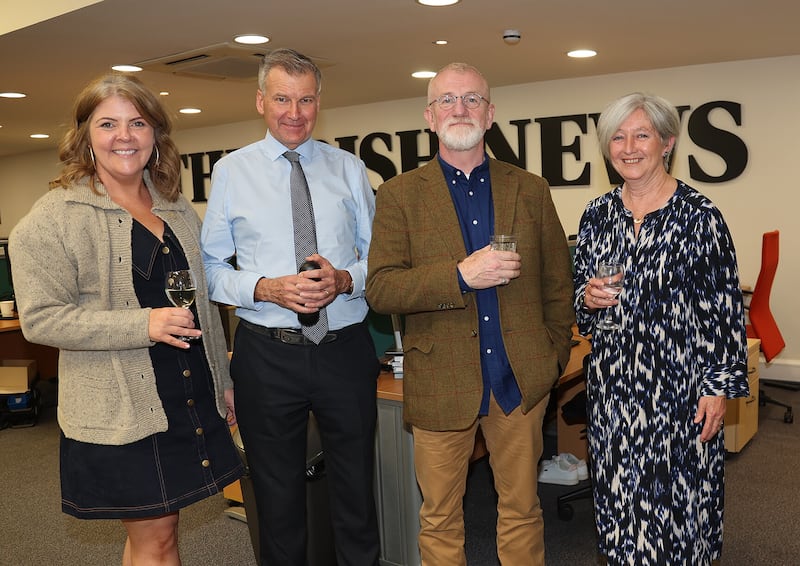
On the Irish News side stood the majestic St Patrick's Church. Above the PP's house was a hairdresser - Mickey Donnelly, who emigrated to Australia. He left behind a young apprentice hairdresser in future 1968 Olympic Games lightweight boxer Marty Quinn, later to open his own barber's shop, also on Donegall Street. Marty trained alongside the fabled Ardoyne fighter Freddie Gilroy in the St John Bosco gym in the old CBS Primary School building close to St Patrick's.
Not far away from the road junction at the top of Donegall Street lay Jim Creagh's newsagent's shop - and a little further up the street the wonderfully named printing house of Reed and Wright.
At the lower end of upper Donegall Street was Meenan's furniture store and the Temperance Hotel - a contrast to Frank McGlade's ground level public bar and upstairs lounge, a focal point for journalists where Ian Whoriskey was the manager. On Royal Avenue stood the Belfast Telegraph, with part of the front the chemist's shop of Harry Moore, who had developed a special cure for hangovers…
Back inside the Irish News front office a mahogany counter was the brisk business end of the operation - the sale of advertisement and a constant stream of local folk submitting 'Death and In Memoriam' notices. Two female telephone operators also served at the counter.
Arms-length inside the counter rested a curiously designed wooden framed and frosted glass surround for a small box-like facility; it housed a very quiet man from off Cavendish Street - Patrick McRory - who was the wages clerk. When he was unavailable through illness or on holiday I was the stand-in.
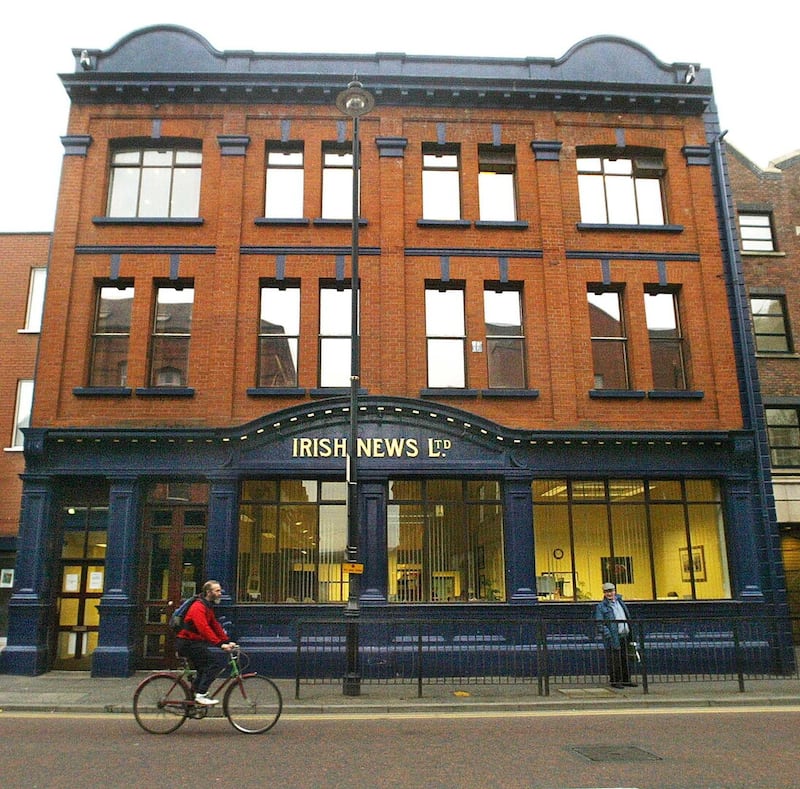
I was also back-up motoring correspondent for Ralph Green, and penned advertising features - mainly for summer holiday retreats to support a healthy list of advertisements. I kept watch on the ordering of newspaper rolls from the Scandia company in Finland.
The front office was a hive of daily activity from early morning, with people booking or collecting printed material from the 'jobbing department'.
My reporting on boxing was mainly then in the amateur section, while club gossip news was handled by freelancer Leslie Mills.
Soon it would be the rise of Barney Eastwood, first as a promoter linked to the shrewd Mike Callahan.
Some outstanding match-ups in the Ulster Hall included the ring rivalry of Slate Street's Peter Sharpe and Doagh middleweight Henry Turkington.
The Irish News office was often awash with old fighters, in to tell their history - including past Irish welterweight champion and First World War veteran Pat McAllister who, in retirement, was the commissionaire at the Broadway Cinema. Other past and present fighters then to call in included Freddie Gilroy and later his old foe John Caldwell; also Gerry Smyth, down from his retail fruit shop on the Glen Road; Jackie Quinn from the Loney; and Markets trader and ex-pro Barney Ross (alias Young Gilmore), who encouraged me to publicise a then growing sport of pony trotting.
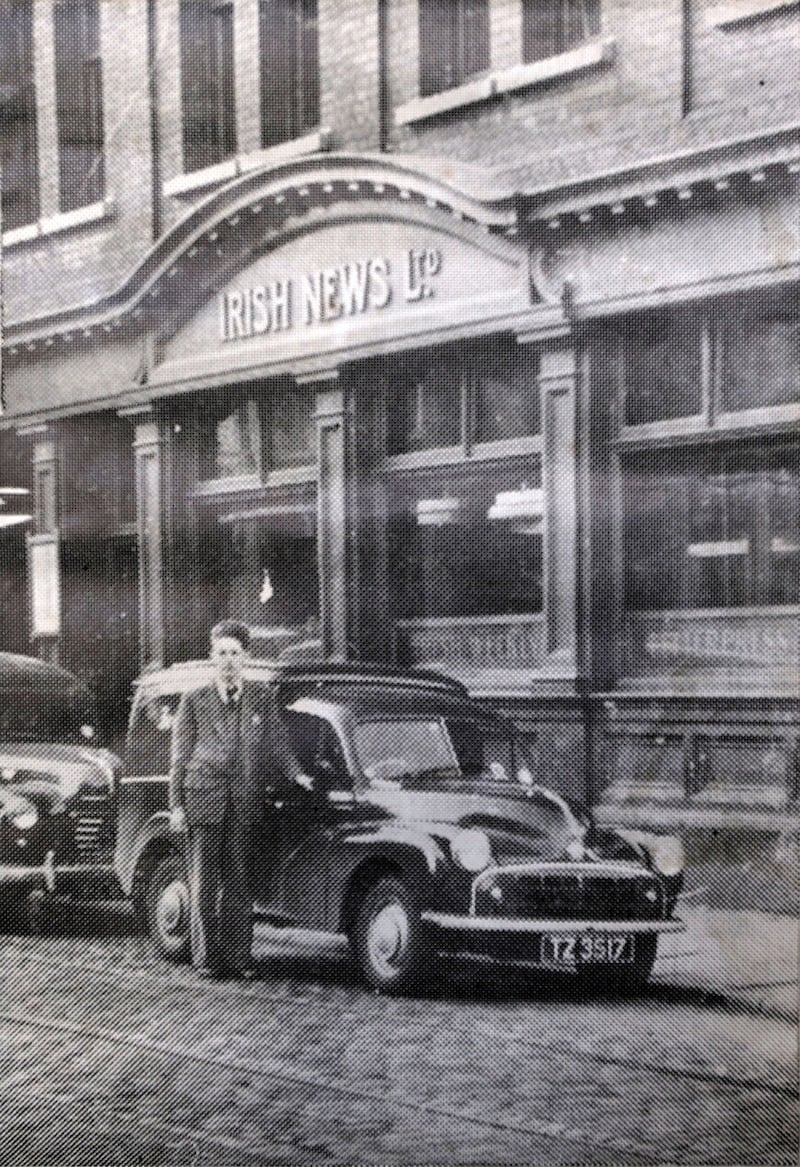
Around the corner was the Shamrock Service Station on Great Patrick Street, where the famous world flyweight champion John 'Rinty' Monaghan was, for a time, the added attraction while working as a 'gas jockey'.
It was owned by south Armagh GAA follower Phil Moley, who also had the enterprising car hire firm of Moley's Motors in Victoria Square and this, along with the Brennan family's Star Taxis and Hire on the Crumlin Road, were big magnets for the Irish News advertising representatives.
You will detect the boxing theme running through Belfast and media interests during the sixties; The Irish News summaries of the sport were greatly respected. It was a time of thrust in the daily sales of the paper, significantly boosted by global successes of professional boxers Billy 'Spider' Kelly, Freddie Gilroy, John Caldwell and amateur Olympic star Jim McCourt - not forgetting the massive increased interest in Gaelic football affairs from Down's historic first win of the Sam Maguire Cup in 1960.
Another attraction was the rising interest in showbands, and this inspired news reporter Paddy O'Flaherty to pen a weekly two-page 'Pat Brady' entertainment issue that drew in loads of lolly in advertisements from professional halls to parish centres. Soon to be involved was enterprising promoter Jim Aiken. Also in the mix were occasional boxing promotions by bookmakers Larry McMahon and Sean Graham.
Showbiz personalities kept popping up at the front counter to encourage a promotion push by the banjo-strumming amateur musician O'Flaherty.
Further back from the front setting of the building - and sealed off by another wood/glass partition from floor to ceiling - was the accounts department. The head bookkeeper was Seamus Bracken, older brother of Frankie - later to become top horse racing tipster.
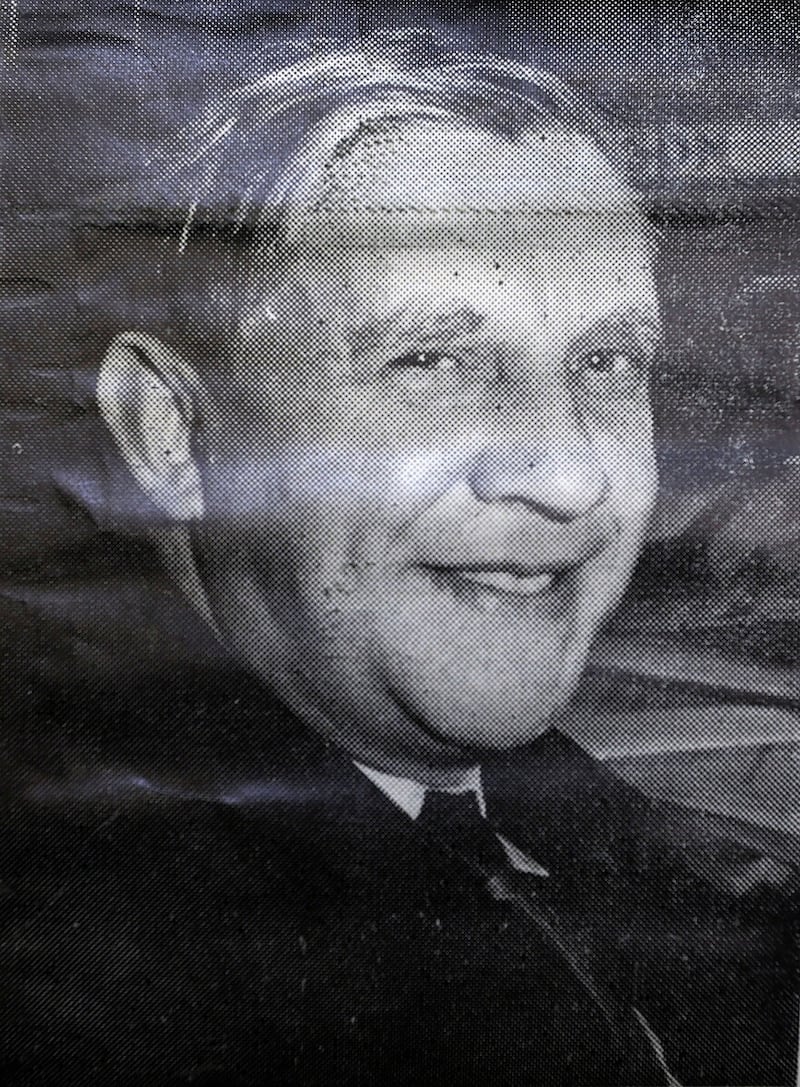
The Belfast accountancy firm of Edward Comerton had Eddie Comerton Jnr in to complete the financial summary for the AGM when the main shareholders assembled in the Royal Avenue Hotel.
Deeper into the ground floor layout of the building that covered a stream running into the river Farset, was the jobbing department, run by former O'Connell's and Antrim hurler Frank Lewis.
His main support in setting hot metal print was a true gentleman: Tommy McIlveen Snr from the Fruithill area of the city, and later to be appointed manager was Tommy McIlveen Jnr.
Also there was long-serving machine operator Hugh Curran, whose brother Bernard was head of the Donegal railway system.
The extremely modest Hugh, from the Cliftonville Road, was the proud uncle of accomplished opera singer, Una Lavery, who married noted Belfast thespian Maurice O'Callaghan.
Amid the hectic happenings of the jobbing section was a former top Irish League wing back Jimmy Ferran - winner of a multitude of medals with a once all-conquering Glentoran team. He was adept at setting wooden type upside down for posters and the likes. Some posters had printed notices to hang in Irish News poster boards outside newsagents' shops.
I believe Jimmy, a hard-man Glentoran double act with former Down All-Ireland JFC title winner Noel McCarthy, defied the Rule 27 and featured in Gaelic football with a prominent Belfast club.
Both Ferran and McCarthy were in the Glentoran team that lost in the last Irish FA Cup final marathon that required two replays… losing to the Jimmy Delaney-inspired Derry City in 1954.
To reach the jobbing section or the print room, and avoid the front office, there was the side door and alley, usually the patrol domain of a general factotum, Frank Quinn, from the Falls Road.
He kept lone weekend vigils to make sure the noble building was secure during the non-working Saturdays through to re-opening for business on Sunday afternoon. House repairs, when necessary, were executed by the handyman firm of Feenan and Rafferty of Friendly Street in the Markets.
At the very back of the building was the big powerful print machine, with lead engineer Frank Gilligan from Beechmount in charge.
Frank supervised willing workers in the print section such as the Canavan brothers, Matt McVeigh and a former professional boxer named Billy Robinson.
Before activating the huge machine, hot metal circular plates were attached to a drum before feeding in newsprint to the machine.
The pages, obviously, had to be in order and then the ink supply checked before Frank Gilligan pressed the button to start the big print, with copies of the Irish News pouring out to be tied up in the allotted brown covered tied packages with named labels stuck to be taken by the vans to the newsagents.
An early issue was rushed to the Great Northern train station, the packages mainly for delivery to Dublin's Eason's shop on O'Connell Street.
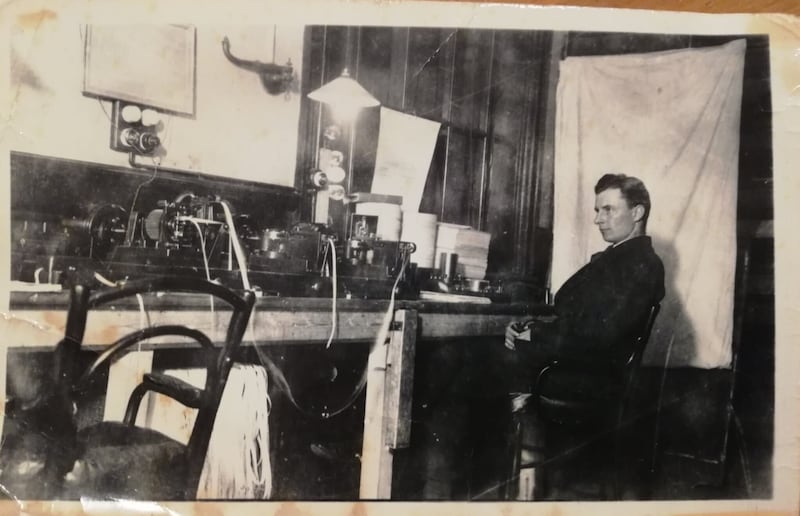
Once print time arrived, around 2.30am, night owls heard the racket of the machine in full throttle and materialised at the back roller door - including former professional Belfast middleweight Barney Wilson, father of the future NI heavyweight champion of the same name.
Sure to keep the chat flowing was the endless chirping of Frank Carson, father of the famous comedian of the same name. The elder Carson arrived on a butcher's bike to collect his order of copies, placed the papers in a basket and took off to sell the papers in the Durham Street area.
First delivery van away was 'the Derry run', the driver Patsy Fagan from the lower Antrim Road.
One of the inner city delivery drivers was a chirpy character from the New Lodge area named Paddy McVeigh, whose brother Matt was also on the Irish News payroll in the print room. Out in the country the north Antrim run was in the safe driving hands of Willie Carey of Cushendun or former NI hill climb and go-kart champion Terry Walsh, also of Cushendun.
In 1960 a meeting of minds agreed on a joint delivery system involving the three morning papers. The Henderson family of the News Letter and the Cunningham family of the Northern Whig sat down with Irish News representatives to work out a finance-saving joint delivery system - until the Whig closed for good, taken over by Porters and then Eason's.
Working for the circulation department then was a Gerry Devlin, once from a vintner's family in Dungannon that moved to Belfast. He lived a stone's throw from Celtic Park. If my memory retention serves me right I recall being told Gerry's sister married iconic street fighter and Allam's Cattle sales drover, Patrick 'Silver 'McKee.
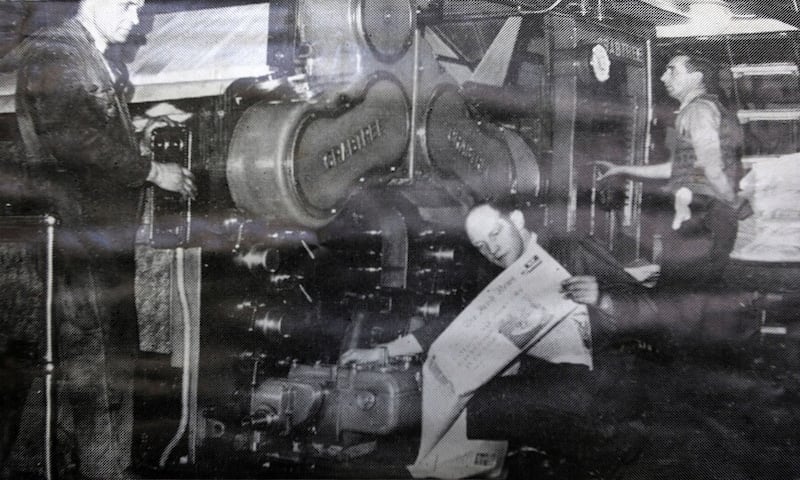
Later to take full control of all aspects of circulation during a period when the daily sales figure was in excess of 60,000 was the very dedicated Irish News man, Terry Cassidy from the Antrim Road. Terry typified a proud loyalty to the firm, adding to the family atmosphere.
Also in the management mix was top man Tom Kerr from Andersonstown, who was succeeded as company manager by his son Eddie. Coming through the ranks was Belfast Rossa hurler Peter O'Reilly, whose brother Jimmy was a regular full back in the club and Antrim hurling colours.
The main advertising sales representatives, under advertising manager Joe Neeson - whose family owned a newsagent's shop on Cromac Street - were dapper Billy Walker from the Cliftonville Road and Jim McCorry, who resided over a pub in the Markets.
Jim's first cousin Penny Calvert became a Tiller girl dancer in London and was the first wife of Bruce Forsyth. Later, Paddy Meehan- a tall top amateur golfer and road cycling enthusiast from Lenaderg, Banbridge - took over the grinding responsibilities of advertising manager.
The Irish News had a broad, cosmopolitan and happy workforce. On one memorable occasion Miss McSparran arranged and paid for a coach trip day-out for the workers, a group that included livewire folk such as Barney Brennan, Jo McGuigan, Mary Megran, Tommy McIlveen, Johnny Cochrane and Sean Canavan. The destination was Cushendun beach, refreshments in the Cushendun Hotel, then games on the sand and also fun football in the old Riggs playing field.
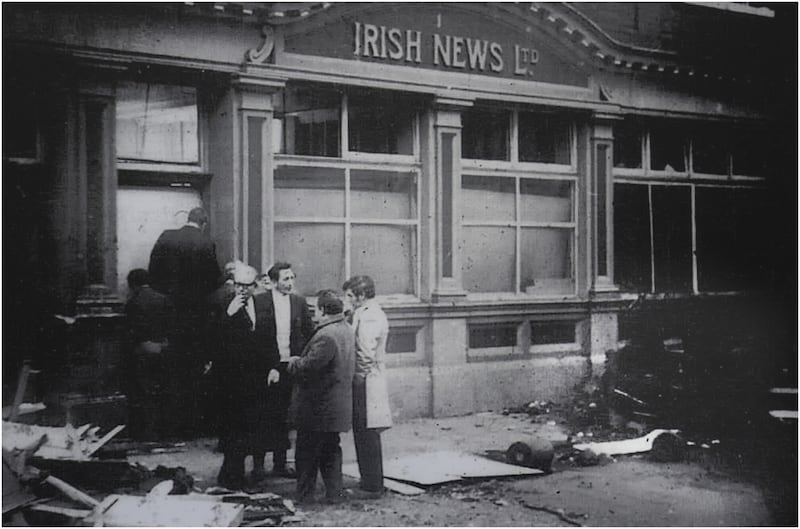
Into the early 1960s Dr Dan McSparran, who retained his GP practice at the corner of Cavendish Street and Falls Road, decided a push in the right direction was needed to entice more ads connected to the farming industry.
So, the Northern Farmer was launched and enjoyed some great support that included the TBF Thompson company in Garvagh.
Mr Thompson had the major sales of various farming machinery, and the NI franchise on JCB machines.
I recall his visits to the Irish News office. An eccentric millionaire, who had a special telephone fitted into the posh Rolls-Royce, scrutinised every word written by yours truly for his sweeping sales production push. The lucrative two-page display started during the early to mid-1960s.
The farming notes also required coverage of the Balmoral spring show, the main summer show and horse jumping competition at Balmoral and also the Ballymena Show. Occasionally, the great Tom Samways, a reporter who served some early years as a journalist in Fleet Street, would be brought in to help me in producing the Northern Farmer.
The farming news once included a trip to Brussels to attend and report on the early launch of the Common Agriculture Policy of the then Common Market.
Before all that, I was honoured to know and be guided by one of the firm's top journalists, quiet man Joe Devlin from the Maghery or Washing Bay area of Tyrone. He sponsored my application to become a member of the NUJ.
Gentleman Joe was appointed editor of the long-since defunct Irish Weekly, taking over from Tim O'Keefe - once an FAI Cup winner when goalkeeper for the Dublin Bohemians Club - who, in turn, succeeded the quaintly quiet but immensely gifted writer Robert 'Bob' Kirkwood.
Every morning one of the company drivers, Charlie Brown, lifted Mr Kirkwood from his home beside St Malachy's College and escorted him to attend Mass in St Patrick's, up the street from the Irish News. Bob Kirkwood had a sister, a nun based in Downpatrick, and a brother Tom, who owned a hostelry at the bottom of the Limestone Road.
The eccentric editor kept pretty much to himself in his own private office, while the deputy then was the lively and efficient journalist Pat Carvill of south Down. Pat would later resign to become managing editor of the News Letter, TV Post and Sunday News. A close ally of Eoin McQuillan, they were once-a-week golfing buddies at Cliftonville or Massereene.
Eoin, after penning a clandestine weekly golf column for the Northern Whig, also left the Irish News in the early 1960s and joined the News Letter staff.
That meant my move to cover all things in senior Gaelic football, hurling, boxing, golf and the added regular sorties to Scotland to report on Glasgow Celtic's progress - including the European Cup finals of 1967 and 1970.
In the sub-editors' room the sports news was overseen by PJ McKeefry of Swatragh.
Midway through my various adventures was the tragic death of Dr Dan McSparran, in September 1964. He had been unwell for some time.
Still, the passing of my special link to the Irish News was a major blow. He was succeeded as company chairman by his son of the same name - affectionately known as Dr Dinty. Sadly, both Dr Dinty and his sister Mary, on their morning drive from Cushendun to the Irish News office, were tragically killed in a car crash in May 1981.
Long before that was the awful 1972 bombing of the Irish News, when I nervously had to hunker down when trapped inside the first floor of the building before the car out front exploded. This was perhaps one reason I moved out, took my young family back to my roots in Cushendun - and on to different challenges in sports journalism.
Despite my decision to leave the Irish News I still look back with warmth at the memories of a time when passing through the portals during my opening years were excellent news reporters such as Donal O'Donnell of Newry, who had a Glenravel family background. Just departed was ace Ballymena news reporter Paddy Topping to join Paddy Reynolds in the Irish Press Belfast office.
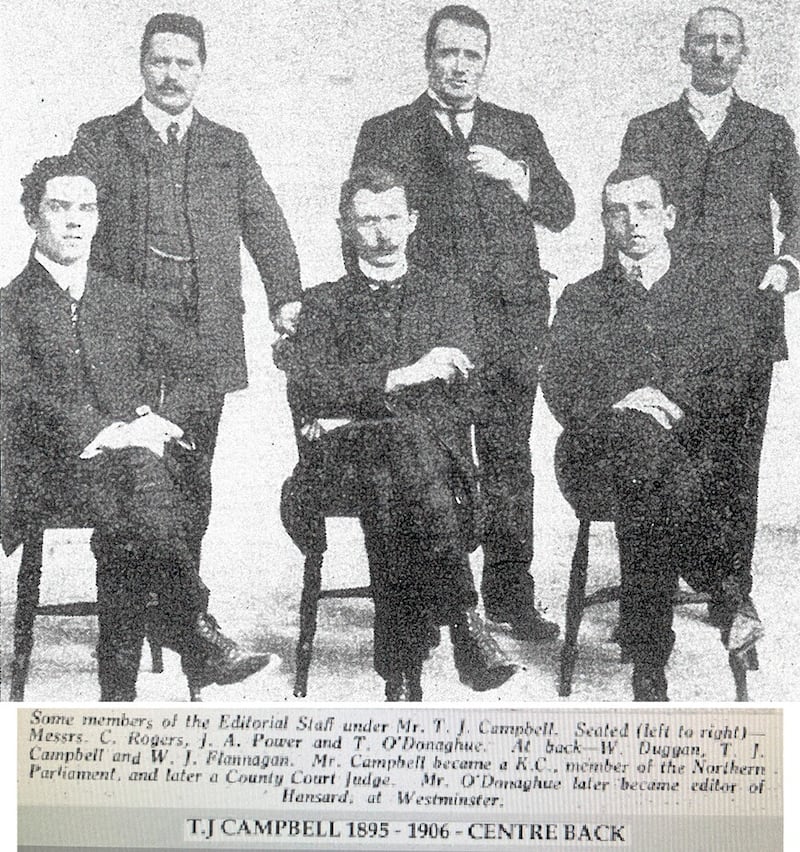
The news editor was Hugh Young, a slick shorthand operator from Andersonstown and once the High Court reporter. He could land you with all sorts of jobs, such as covering the Antrim Education Board meetings in the Crumlin Courthouse.
Hugh was also in charge of a quirky weekly news items or strange yarns of around two paragraphs - under the banner of 'Random Jottings'. Submitting a wee story earned you an extra 2/6.
I recall being assigned by Hugh Young to interview Austin Currie in the reporters' room - the Tyrone politician pushing news of unfair and uneven house allocations within his county.
Little did I know that not far up ahead was the brutal Burntollet battle that changed the face of local politics forever.
Soon after that arrived the start to the Troubles, with myself and Paddy O'Flaherty assigned to observe the riots and report on the petrol bomb battles at Dover Street and Lower Falls. I was stationed near Dover Street, skulking in the doorway of Sean Stinson's furniture shop.
No mobile telephones in those dark dangerous days, and with most of the red telephone boxes barbecued by the rioters you had to hoof it back through the old Smithfield Square to the office and place the awfulness down on paper in a rickety typewriter.
Generally, the night news reporter and copy taker supreme was the laconic Peter McNulty of Newry. A first class reporter, he preferred the night shift to daytime routines.
Peter could gently halt you in your flow of phoned-in ad-libbed copy, to let you know of a verb or adjective already used or out of place.
He could adjust the copy in an instant, while lighting up yet another fag at the same time.
Another gifted reporter also plagued by night copy taking was Dominic Cunningham, from the Ballynahinch area, who later became Belfast news editor for Independent Newspapers.
I'm still in reflective wonder how Dominic could hear my copy delivery over the sound of klaxons during a Celtic football final in Milan.
A delightful character with a wry sense of humour, he had the misfortune to be on night town duty and had to type in the ad-libbed copy of the extra-time match report from the San Siro.
Across the street from the Irish News front door was the Rodgers Bar, a sanctuary of rest for night subs and time for a quick pint and a puff on a fag before slipping back up the stairs to the first-floor editorial offices. The trick was to make sure the teetotaller boss of bosses, Bob Kirkwood, did not witness the roving subs' return.
Veteran news sub was part-time poet Alfie Woods, whose brother was an acclaimed landscape artist. Alfie could make a small pencil stub last an eternity.
Also trying to make sense of submitted news and feature copy were other veterans of the game such as Jimmy Sherrard, John Foster and Willie Swinnerton. They had been around the block as journalists with some of the other city publications.
Also coming on board the editorial staff in the latish 1960s was Ted Gallagher, a family connect to Tim O'Keefe. Ted, I believe, was previously with the Cork Examiner - and would later succeed the hugely respected Tim O'Keefe before I left the company in 1973.
The creed room on the top floor spouted miles of daily copy that included horse-racing cards, world PA and Reuters sports reports and previews. In charge of the ever-clattering machines, a move up from the old ticker tape days, affable Ardoyne man Jimmy McLaughlin. He also penned copy for billiards affairs.
Handball notes were submitted by Eamonn Clarke of Ardoyne. Cycling copy was by in-house machinist Jim Traynor. News and sports news from outside the city were in the hands of reliable country correspondents, once known as the 'penny liners'.
They included Frank Curran in Derry, P J Wall in Magherafelt, James MacRory in Ballymena, Brendan Smith of Ballybay, Matt Fitzpatrick with GAA news from east and south Down, Mr Curran of Newcastle and the McGahon family of the Dundalk Democrat, who provided a regular service of copy for the Dundalk Race track.
The greyhound notes for Celtic Park and Dunmore Stadium were in the hands of Brendan Smyth, whose sister, Maureen supplied camogie notes. Brendan, a freelance, left to join the News Letter/Sunday News and was tragically killed in a car crash on Belfast's Shore Road. Taking over the Greyhound previews and reports was wily street-wise Matt Rosbotham, known as 'Tracker'.
In a strange world, the Irish News then did not have a staff photographer, but survived through the use of two freelance operators.
One was Co Armagh-born Eddie Dineen, a bachelor with Co Cork family roots who lived in the Castlereagh Road area and was an early member of the Belfast Press Golf Society.
The other shutter man was, unbelievably, former cruise ship dance band percussionist George Craig, who had vision only in one eye.
George decided to abandon ship, return home to dry land and, despite the obvious physical handicap, turn his pastime of photography into a lucrative business. He lived in Joy Street, where he developed his films.
Not many folk will remember the Irish Weekly, once a staple diet of reading before, during and after the Second World War for people living in outlaying areas. There was also a Scottish edition of the Weekly, featuring lots of news of Glasgow Celtic's affairs in Scottish football. The Glasgow manager of the Weekly was Mr Mick Fallon.
I met him a few times, while over near the Clyde reporting on major Celtic matches.
With me then as Irish News soccer critic was the famous 'Cheeky' Charlie Tully. He proffered the words of wisdom. I typed the copy.
Because of the McSparran family connection to the Belfast and Glasgow Celtic clubs I had an annual summer engagement in Cushendall, when Sir Bob Kelly, chairman of Glasgow Celtic, took his holiday spell with his relatives, the O'Reilly family, in the Northern Bank building on Shore Street.
I took Tully down to meet his old revered boss Kelly. We had a photographer in tow to complete the memory lane meeting.
Long since retired, the inimitable Tully was back home from Scotland and living in his native St James' district. He was the local area representative for McKinley's Scotch whisky.
* This aticle was amended on June 15 2023
